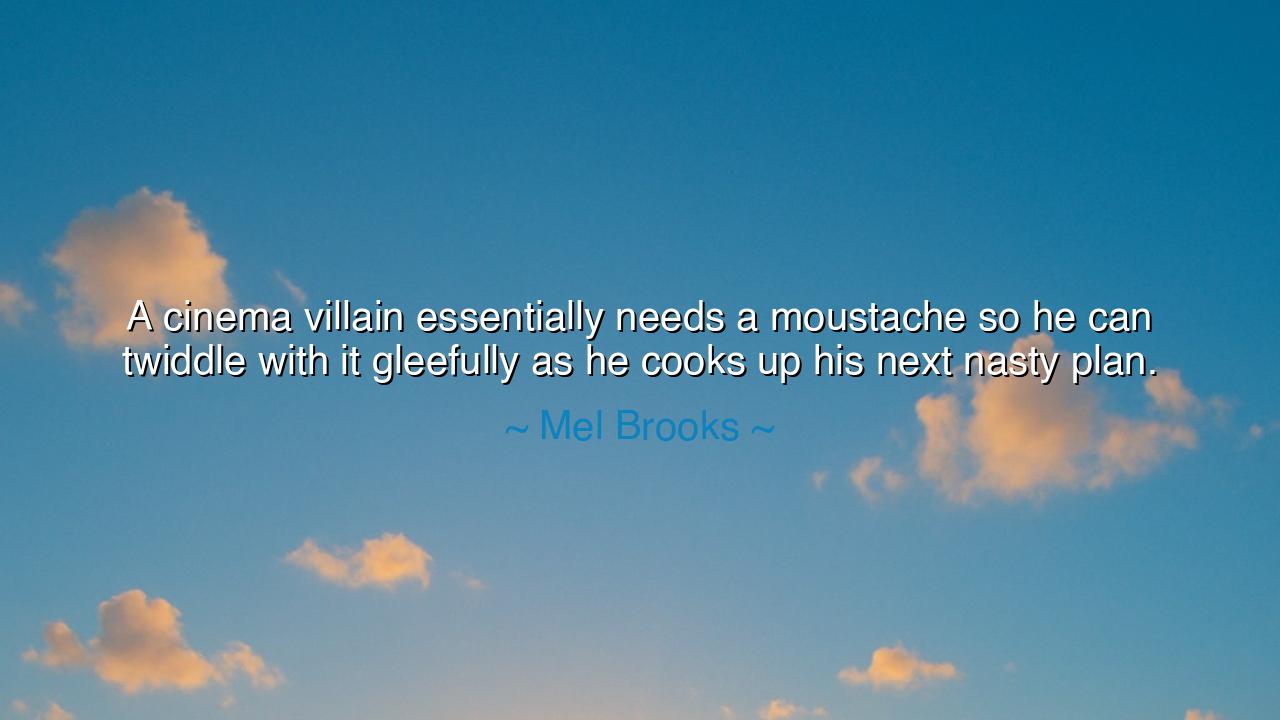
A cinema villain essentially needs a moustache so he can twiddle
A cinema villain essentially needs a moustache so he can twiddle with it gleefully as he cooks up his next nasty plan.






"A cinema villain essentially needs a moustache so he can twiddle with it gleefully as he cooks up his next nasty plan." With these playful words, Mel Brooks invites us to laugh at the often absurd but deeply ingrained tropes of storytelling, particularly in the realm of cinema. The villain, that timeless figure of darkness and mischief, is often marked by exaggerated traits, and in Brooks' quip, the moustache becomes the symbol of this theatricality — a visual marker of villainy. The twirling of a moustache, as if some devious thought is being spun, is not merely for show but speaks to the archetype of the evil mastermind, plotting his next move with a twisted sense of joy. This image, while humorous, captures something profound about how we craft and perceive evil in stories.
In the ancient world, the concept of the villain was often embodied in gods and monsters who stood in opposition to the heroic journey. Hercules, that mighty hero, was constantly pitted against enemies who were often larger-than-life figures, such as the Hydra or the vengeful Hera. These villains, though more complex in their motivations than the moustache-twirling stereotypes of later times, still represented chaos, destruction, and disruption to the natural order. Just as the ancient gods and monsters stood against the hero's path, so too do modern villains stand against the progress of the protagonist, their wicked plans often betrayed by their dramatic flourishes — like a twisted moustache or a sinister laugh.
Consider the Shakespearean villains like Iago in Othello, whose machinations are subtle yet driven by deep envy and malice. Though Shakespeare’s villainy is far from caricatured, the archetype of the villain still holds true — their plans are intricate, deceptive, and fueled by a desire to control and destroy. The twirling of the moustache may have evolved into a more nuanced form in literature and theater, but it still speaks to the same dramatic need for villains to relish their power over others, to delight in the suffering they cause. In this sense, the villain becomes not just an antagonist, but a representation of disorder, using whatever tools, whether moustaches or manipulation, to disrupt the harmony of the world.
In more modern times, cinema has adopted these traits, exaggerating them to create the iconic villains we know today. Think of Dr. No from the James Bond films or Count Dracula, whose looks and behavior are exaggerated, almost caricatured, to heighten their sense of menace. Brooks’ remark about the twirling moustache taps into this long-standing tradition of cinema villains who indulge in their evil with dramatic flair. These characters are often marked by their delight in scheming, their ability to plot and plan with cold calculation. It is not just that they are evil, but that they take a pleasure in the evil they do, and it is this joyful malice that makes them memorable.
In the real world, however, the face of villainy is often more subtle, even hiding behind a smile rather than a sinister twirl. But the essence remains the same. Throughout history, tyrants, despots, and dictators have employed their devious plans not in a theatrical manner, but with a chilling calmness that makes their actions all the more dangerous. Adolf Hitler, for instance, did not twirl a moustache while laughing wickedly; instead, he plotted a course for unimaginable suffering with a calculated ruthlessness that cast its shadow over millions. The true villainy of history is not necessarily in the dramatic flourish but in the calculation and desperation that fuel such deeds.
Mel Brooks, in his humorous reflection, points to a truth about storytelling and the way we portray evil: villains are often designed to be larger than life, to be obvious in their cruelty, so the audience can easily distinguish them from the hero. But in doing so, we also learn a valuable lesson: the greatest evil often lies not in the twirling of a moustache or the obviousness of the antagonist’s motives, but in the quiet, insidious plans that go unnoticed until it is too late. The true villain in life is not always the one who cackles in the shadows, but the one who moves with subtlety, whose actions leave no trace, and whose plans unfold under the guise of innocence.
Let us take from Brooks’ wit a deeper lesson: the moustache-twirling villain, while entertaining, is also a reminder to be wary of those who seem too dramatic, too obviously evil, for true danger often wears the mask of charm, persuasion, or authority. As we navigate our own lives, we should not just look for the flamboyant enemy, but for the quiet disruptor, the one who may not twirl a moustache, but whose intentions are no less harmful. The lesson here is clear: evil is not always loud; sometimes, it is silent, subtle, and even charming. It is in recognizing both the dramatic and the hidden forms of villainy that we protect ourselves and our world.






AAdministratorAdministrator
Welcome, honored guests. Please leave a comment, we will respond soon